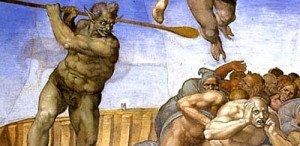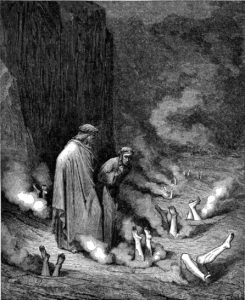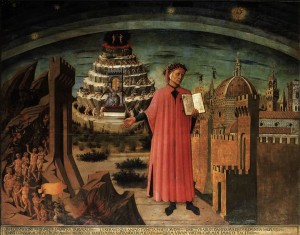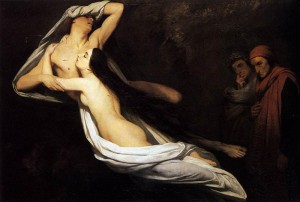
“Dante and Shakespeare divide the modern world between them, there is no third.” T.S. Eliot
Dante’s Inferno is a journey through Hell. It is the first part of Dante’s epic poem, The Divine Comedy, describing an incredible visit through the afterlife of Hell, Purgatory, and Heaven. Reading Dante’s Divine Comedy for the first time can be confusing. The poem includes references to classical literature, medieval theology, Italian politics, and literary issues that scholars are still debating. In addition, there are many translations (some good, some not so good) to choose from. This article will help you get started on this amazing and very rewarding journey.

Story Summary
The story begins with Dante waking from a deep sleep, lost in a dark wood. After a few unsuccessful attempts at escape, he encounters the poet Virgil, who tells Dante the only way out is down the center of the earth through Hell (Inferno). Virgil leads Dante through Hell, encountering terrifying scenes of punishment as well as meeting up with various inhabitants from Florence, the Bible, and classical literature. The journey through Hell ends with Dante and Virgil encountering Satan and escaping out the other side of the earth, the entrance to Purgatory. The two travelers climb mountain of Purgatory, where they join all those destined for Heaven in their journey of purification. Just as in Hell, Dante meets up with real and fictional characters, each with a story to tell. Near the top of the mountain of Purgatory, Dante changes guides and begins his journey through Paradise (Heaven) culminating in a vision of God.

Dante’s Life
Dante Alighieri was born in Florence around 1265. He had a good education and was influenced in large measure by the writings of the poet Virgil, specifically his work, The Aeneid. Themes and characters from The Aeneid appear regularly in the Divine Comedy. Florentine politics also plays a major role in the story and characters of the Divine Comedy. That period of history was dominated by power struggles within the various city states in Italy. The two groups competing for power in Florence were the Guelphs (artisans, new money, lesser nobility, pro-Papacy) and the Ghibelline’s (old money, aristocracy, pro-Holy Roman Emperor). These divisions, typically followed family lineage, with Dante being a member of the Guelph party. Through much of Dante’s life, the Guelphs were in power, in fact Dante held a government position for a time. However, a bitter split developed within the Guelph party creating two factions, the Whites (to which Dante belonged), and the Blacks. Pope Boniface VIII eventually sided with the Black Guelphs, and consequently Dante was exiled from Florence. It’s no accident that Boniface ends up in Hell in Dante’s poem.

The Divine Comedy was written when Dante was exiled from his beloved city of Florence (to which he never returned). Exile and redemption are themes which run throughout this work. In addition, many of Dante’s political friends and enemies appear in the different sections of the afterlife. The character of Beatrice in the poem is believed to be the real woman, Beatrice Portinari, whom Dante knew and possibly fell in love with (however she was married) in Florence. Dante went on to write his first major work, Vita Nuova, as a love poem to her. Beatrice died at a young age, and although Dante did get married, he never seemed to recover from her death. Beatrice’s role in the Divine Comedy has come to represent all that is good, as well as the theological personification of grace.
The Divine Comedy can be read at so many levels; poetry, narrative, political, theological. Dante scholars have written volumes on this amazing work, and continue to do so to this day.
The Comedy
The term comedy refers to the fact that this work has a happy ending and is written in the vernacular, unlike tragedy. Although there are many comical points in the work as well. The Divine Comedy can be read at many levels; poetry, narrative, political, and theological. Dante scholars have written volumes on this amazing work, and continue to do so to this day.
The Poetry
Dante’s Divine Comedy is not only a classic story, but also a masterpiece of poetry. It is the first major classical poem written in Italian. Previously, classical poetry was written in Latin. The number 3 plays an important part in the divisions of this book, representing the 3 Persons of the Trinity. The work is divided into 3 books, each book is divided into chapters, or Cantos. The books are: 1. Inferno (Hell) containing 33 cantos plus one introductory Canto. 2. Purgatorio (Purgatory) containing 33 Cantos. 3. Paradiso (Paradise) containing 33 Cantos. The cantos are divided into 3 line units called Tercets. Dante also devised a rhyme scheme which he called terza rima . The rhyme scheme is: aba, bcb, cdc, ded, etc. When you hear this read out loud, this scheme pushes the poem forward, keeping the journey moving. Here is the beginning of the first canto, showing the rhyme
- Nel mezzo del cammin di nostra vita (a)
- mi ritrovai per una selva oscura. (b)
- ché la diritta via era smarrita. (a)
- Ahi quanto a dir qual era è cosa dura (b)
- esta selva selvaggia e aspra e forte (c)
- che nel pensier rinova la paura! (b)
- Tant’è amara che poco è più morte; (c)
- ma per trattar del ben ch’i’ vi trovai, (d)
- dirò de l’altre cose ch’i’ v’ho scorte. (c)
Some editions have side by side English and Italian text, which can greatly enhance the experience of reading the Divine Comedy.
The Divine Comedy is work of literature that is timeless and grows as we grow.
Comments Open
What is the best, most artful translation of THE DIVINE COMEDY?
Loved your intro, (my version is translated by John Ciardi, a great version. I get pleasantly lost and distracted, reading the footnotes, they are an amazing part of the volume! Are you familiar with this one?)
I will continue with your journey…
DebErie
being an absolute beginner…this is amazing to me. never knew history or that Dante actually existed. And by reading this page, it seems (as from most writers) that events and the journey (however fantastic) are originating from real life experiences. I am taking notes on the different versions here-i’ll have to pick one up now. Images are phenom on your blog as well – from where do they originate? thanks Dave very nice.
Divine Comedy is always a classic.
Im not an habitual reader, but i decided to give it a try, this is not a good book to start the lecture habit, but when i come to this book i will know hoe to read it, thanks to this post.
I read this poem and I liked it.
With my group of less than enthusiastic students, I am using Hollander’s notes for some of it and Ciardi’s for other parts. It helps that I love it but it does take some work to figure it out.
When I read these books, I had a bit of difficulty reading between the lines. I can’t say I grasp the entire idea very well. However, I enjoyed reading it despite the rhymes and riddles. I wonder if anyone would do a movie on this. I’d like to see how it all looks in another person’s eyes.
This comedic version of Dante’s story appears to be an excellent poetic story. Your synopsis and translations of this poem made for an easy read and was very well written.
When I was in the secondary school, my teacher discuss about Divine Comedy. But I don’t understand what Dante is. Is he a poet dreaming about inferno, purgatorio and paradiso?
Just joined up always up for discussions on my most favourite writing of all time, one copy that i have found maybe the most difficult to read but also the most poetic, how can you go wrong with Longfellows edition.